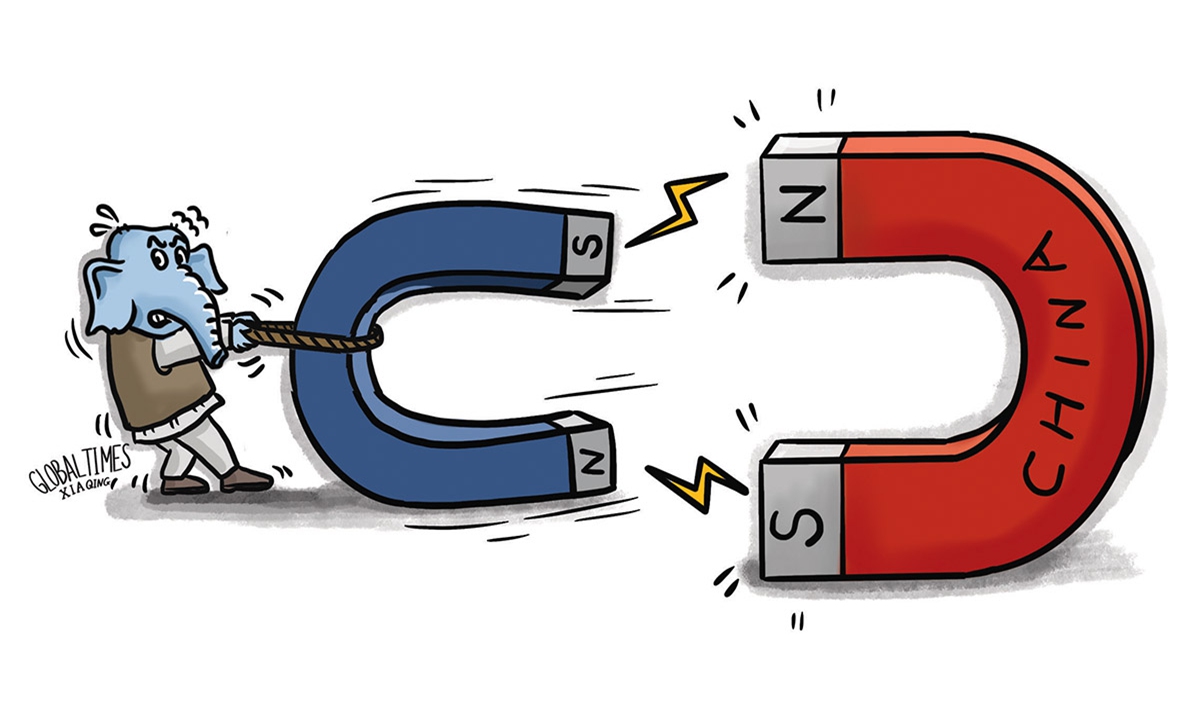
India Illustration: Xia Qing/Global Times
Observers had estimated that bilateral trade between China and India might surpass the milestone of $100 billion in 2021 despite a cold political and diplomatic relationship between the two nations. The latest trade data from China's Customs revealed that the new record was reached in October as two-way trade totaled $102.29 billion in the first 10 months of the year, surging 47.8 percent year-on-year.
In US dollar terms, China's exports to India came in at $78.33 billion during the 10 months, up 51 percent year-on-year, with China's imports from India totaling $23.96 billion in the same period, up 38.2 percent on a yearly basis, according to data from China's General Administration of Customs.
The target of $100 billion in trade between China and India per year was proposed over 10 years ago. The milestone was attained at a time when their bilateral relations are fraught while New Delhi is advocating a "decoupling" from China approach.
The latest trade figures also serve as a timely reminder for India's Modi government to redress their incorrect path and once again showing that it is anything but an easy task for India to cut economic and trade links with China.
In spite of reluctance, India is deeply intertwined in a global value chain in which China is playing a central role. Many Indian export-oriented businesses rely heavily on raw materials from China, such as bulk pharmaceutical chemicals, photovoltaic modules and raw silk.
And, COVID-19 also boosted trade growth between the two nations, as India was hard hit by the pandemic while China became increasingly essential among the global industrial chain due to China's effective epidemic containment. And, China's increased imports of iron ore and other materials from India in the first half of the year have also contributed to the trade surge.
There are short-term drivers behind the "$100 billion" milestone, and, analysts warn that the growing momentum of the bilateral trade may prove hard to maintain as the Indian government has not given up its policy of an economic decoupling from China.
Holding onto a long-cherished dream of becoming a leading power in the world, India has chosen a reckless approach of cutting engagement with China, even turning its back to regional free trade agreements in which China plays a prominent role, such as the Regional Comprehensive Economic Partnership (RCEP) - a mega free trade deal that includes about 30 percent of the world's total GDP and population.
Under these circumstances, it would be the most sensible path for India to join the regional trade pact and help enhance its own production capacity if New Delhi aspires to have a say in the global value chain.
But the policies meted out by New Delhi are not helpful to build up Indian domestic production capacity, and the policies will also generate serious negative side-effects, possibly shadowing the South Asian country's long-term development.
The Modi government has been promoting its Made-in-India campaign for many years but has failed to deliver. And, New Delhi's so-called economic decoupling approach has been proved futile. In contrast, the Chinese market has kept its door open to the world, including Indian companies.
The merits of economic cooperation and partnership with a huge economy like China are plain for all to see, however, New Delhi, responding to the urge of the Biden administration, has indulged in playing geopolitical games with China, at the cost of its future growth.
The article was compiled based on an interview with Liu Zongyi, secretary-general of the Research Center for China-South Asia Cooperation at the Shanghai Institutes for International Studies. bizopinion@glboaltimes.com.cn




